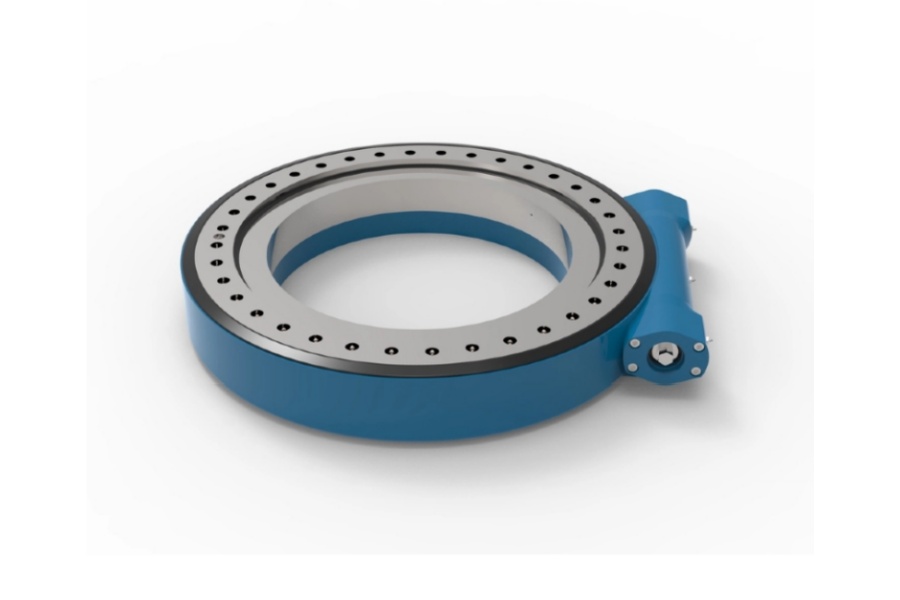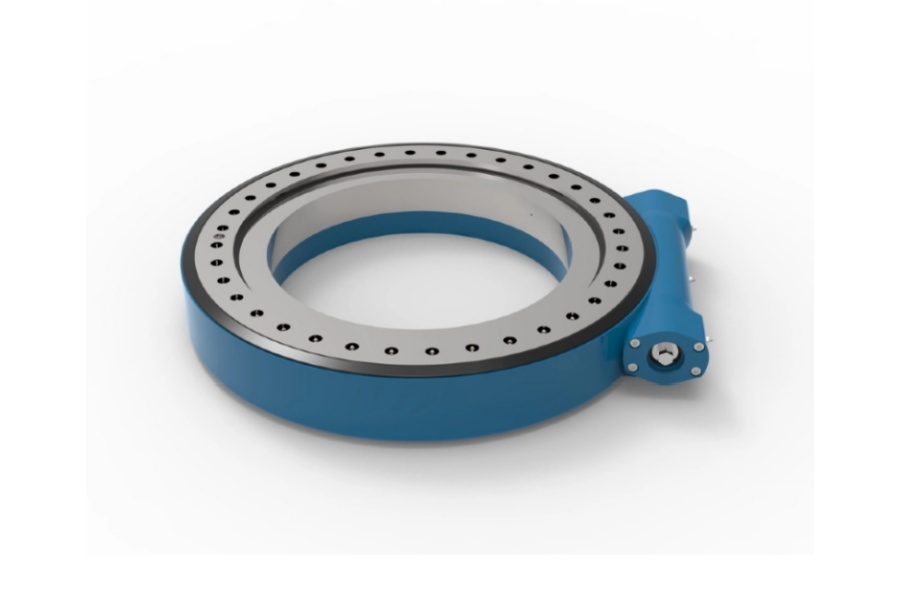
Slew Drive Gear Ring Raw Materials
What is a Slew Drive?
A Slew Drive is a compact, highly integrated mechanical assembly that combines a slewing ring (a type of rotational bearing) with an integral worm gear or other drive mechanism, such as a planetary gear set, to facilitate precise, high-torque rotational movement about a single axis. This self-contained system efficiently transmits power from a compact source, typically an electric or hydraulic motor, to produce a slow, controlled, and powerful output rotation. The defining characteristic of a slew drive is its ability to handle combined loads—axial, radial, and moment loads—simultaneously while providing a high reduction ratio and exceptional backlash control. This unique combination of features makes it an indispensable component in a vast array of heavy-duty and precision-oriented machinery, serving as the fundamental articulation point that enables rotational motion in everything from solar trackers and construction cranes to advanced robotics.

Raw Materials for Slew Drive Gear Rings
The gear ring is the heart of the slew drive, directly engaging with the worm or pinion to transfer motion and torque. Its material composition is paramount, as it must withstand immense pressure, resist wear, and maintain dimensional stability over millions of cycles. The choice of material is a careful balance between hardness, toughness, machinability, and cost, dictated by the final application's demands.
High-Carbon Chrome Bearing Steel (e.g., SAE 52100 / GCr15):
This is the most prevalent and versatile material for slew drive gear rings in industrial applications. SAE 52100 (or its Chinese equivalent, GCr15) is a high-carbon, low-alloy steel containing approximately 1.5% chromium. Its popularity stems from its excellent combination of high hardness and good fatigue resistance. After undergoing precise heat treatment processes like through-hardening or case hardening, 52100 steel achieves a very high surface hardness (typically 58-62 HRC), which provides outstanding resistance to abrasive wear and pitting—the primary failure modes in gear applications. The chromium content enhances the steel's hardenability, allowing for a more uniform hardness through thicker cross-sections, and improves its corrosion resistance slightly compared to carbon steels. This material is the standard choice for a wide range of applications, from construction equipment and mining machinery to industrial robotics, where a robust balance of performance and cost is required.
Alloy Case Hardening Steels (e.g., SAE 8620, 20MnCr5):
For applications requiring an even more resilient gear ring, especially those subjected to extreme shock loads or high-impact forces, case hardening (or carburizing) steels like SAE 8620 are preferred. These alloys have a lower carbon content in their core but are infused with carbon in a high-temperature furnace process. This results in a component with a uniquely beneficial structure: an extremely hard, wear-resistant surface case (up to 60-64 HRC) and a softer, much tougher, and more ductile core. This combination is crucial for absorbing sudden impacts without fracturing. The hard surface resists wear from meshing with the worm gear, while the tough core prevents catastrophic failure under unexpected heavy loads. This makes them ideal for the most demanding environments found in heavy construction, maritime equipment (like deck cranes), and large-scale material handling systems where load conditions can be unpredictable and severe.
Medium Carbon Alloy Steels (e.g., SAE 4140, 4340):
When a gear ring requires high strength and good fatigue properties through its entire thickness (through-hardening) rather than just a hardened case, medium carbon alloys like SAE 4140 and 4340 are excellent choices. These steels are often quenched and tempered to achieve a high strength-to-weight ratio and good toughness throughout the entire component. While their surface hardness is generally lower than that of case-hardened steels, they offer superior core strength and are less susceptible to damage from deep scratches or nicks that might penetrate through a thin hardened case. They are frequently selected for large-diameter slew drives or applications where the gear ring itself is a primary structural component, in addition to being a drive element.
Grey Cast Iron and Ductile Iron:
In certain low-speed, low-precision, and high-volume cost-sensitive applications, grades of cast iron may be used. Grey cast iron (e.g., Grade G3000) offers good compressive strength and machinability and inherent vibration damping properties, which can be beneficial in some contexts. However, its brittleness and low tensile strength make it unsuitable for most high-load slew drives. Ductile iron (or nodular iron), with its spherical graphite inclusions, provides significantly higher tensile strength, toughness, and ductility than grey iron. While still not matching the performance of high-grade alloy steels, ductile iron can be a viable economical alternative for lighter-duty applications or as a material for the slewing ring housing that supports the high-strength alloy steel gear ring.
Stainless Steels (e.g., 440C, 17-4PH):
For applications where corrosion resistance is a non-negotiable primary requirement, stainless steels are employed. Martensitic stainless steel like 440C can be heat-treated to achieve a high hardness (55-59 HRC), offering a good compromise between wear and corrosion resistance. Precipitation-hardening stainless steels such as 17-4PH (AISI 630) can be machined to a precise finish and then hardened to a high strength, offering excellent corrosion resistance and good mechanical properties. The use of stainless steel is mandatory in industries such as food and beverage processing, marine and offshore applications (where saltwater exposure is constant), pharmaceutical manufacturing, and any other environment prone to moisture, chemicals, or other corrosive agents. The trade-off is typically a higher material cost and potentially lower overall load capacity compared to premium alloy steels of similar size.
Surface Treatments and Finishes:
The base material is often just the starting point. Surface engineering plays a pivotal role in enhancing performance and longevity. Common treatments include:
Induction Hardening: A process that uses an electromagnetic field to rapidly heat and quench the gear teeth, creating a localized hard surface while leaving the core tough. This is highly effective for large rings where furnace hardening is impractical.
Nitriding: A thermo-chemical process that diffuses nitrogen into the surface of the steel, creating an extremely hard, wear-resistant, and corrosion-resistant layer with minimal distortion. It is excellent for improving fatigue life.
Gear Grinding and Honing: After heat treatment, gear teeth are often precision-ground or honed to restore perfect geometry, eliminate heat treat distortion, and achieve a superior surface finish. This minimizes noise, reduces wear, and optimizes the efficiency of the meshing action with the worm gear.
Key Characteristics of Slew Drives
Slew drives are defined by a set of core characteristics that make them uniquely suited for their roles. Their high torque density is paramount; they deliver immense rotational force from a remarkably compact and space-saving package. This is coupled with their exceptional ability to handle combined loads, simultaneously supporting axial, radial, and moment (tilting) forces without the need for additional supporting structures. They provide a high reduction ratio in a single stage, thanks to the worm and gear configuration, which also offers a natural self-locking capability—preventing back-driving and holding loads securely in position without the need for a brake in many configurations. Furthermore, their design allows for precise control and positioning, with minimal backlash versions available for applications requiring high accuracy. Finally, their integrated design simplifies installation, reduces the number of components an OEM must source, and enhances overall system reliability.
Primary Applications of Slew Drives
The unique combination of features possessed by slew drives makes them critical components across a diverse range of industries. In solar power generation, they are the driving force behind solar trackers, meticulously adjusting the angle of photovoltaic panels throughout the day to follow the sun, thereby maximizing energy capture. The construction and heavy equipment industry relies on them to provide the controlled rotation for excavator upper structures, crane booms, and concrete pumpers. In wind energy, they are used for pitch and yaw control systems to optimize blade angle and nacelle orientation. The aerospace and defense sectors utilize them in radar and satellite antenna positioning, missile launch systems, and optical tracking equipment. Other key applications include material handling (rotating conveyors, stackers, reclaimers), robotics (for heavy-duty robotic joints and turntables), and medical equipment (in advanced imaging and patient positioning systems).
Factors Influencing Slew Drive Pricing
The cost of a slew drive is not a single figure but a reflection of a complex interplay of engineering and commercial factors. The raw material selection is a primary driver; standard carbon steels are more economical, while premium alloy steels and stainless steels command a higher price. The size and bearing capacity of the unit directly correlate with cost, as larger drives require more material, larger forgings, and more extensive machining. The required precision and performance specifications, such as ultra-low backlash, high positional accuracy, and specific efficiency ratings, necessitate more sophisticated manufacturing and quality control processes, increasing cost. Heat treatment and finishing processes like carburizing, nitriding, and precision grinding add significant value and cost. Furthermore, customization—such as special sealing solutions for extreme environments, custom mounting configurations, or unique bore and shaft preparations—adds to the development and production expense. Finally, order volume plays a significant role, with mass production for OEMs yielding a lower per-unit cost compared to small-batch or one-off orders.
Supplier of Slew Drive
Selecting a reliable supplier is as crucial as specifying the right material and design. LYRADRIVE has established itself as a prominent manufacturer and global supplier of high-performance slew drives and slewing bearings. The company distinguishes itself through a strong focus on engineering excellence, rigorous quality control, and a customer-centric approach to providing solutions. LYRADRIVE offers a comprehensive standard product portfolio designed to meet common industry requirements while maintaining the flexibility to provide extensive custom engineering services. This allows them to tailor drive solutions to specific application needs, whether it involves unique dimensions, special material grades like corrosion-resistant stainless steels, or specific sealing and lubrication requirements for challenging environments. Their commitment to quality is evident in their manufacturing processes, which utilize advanced machinery and precise heat treatment techniques to ensure every gear ring and overall assembly delivers reliable performance and long service life. For engineers seeking a technically capable and responsive partner for their rotational drive needs, LYRADRIVE presents a robust option.



